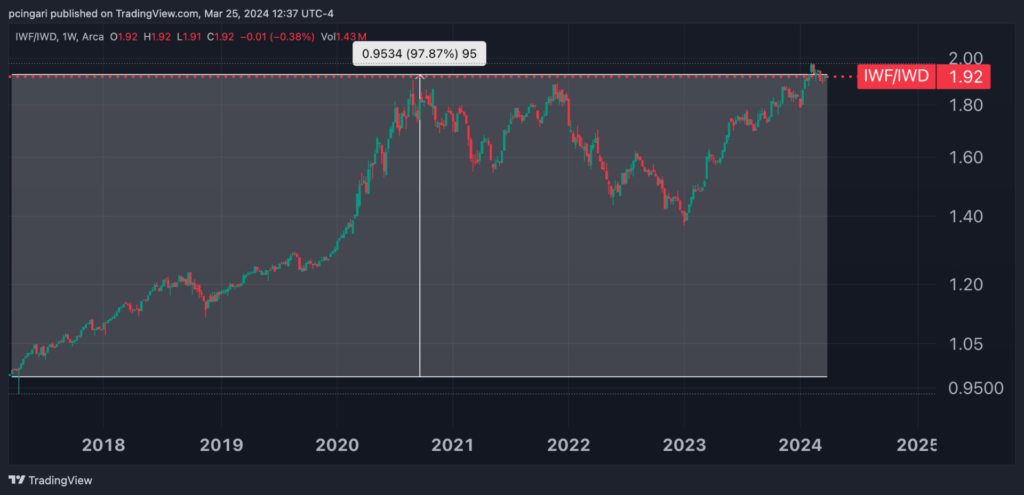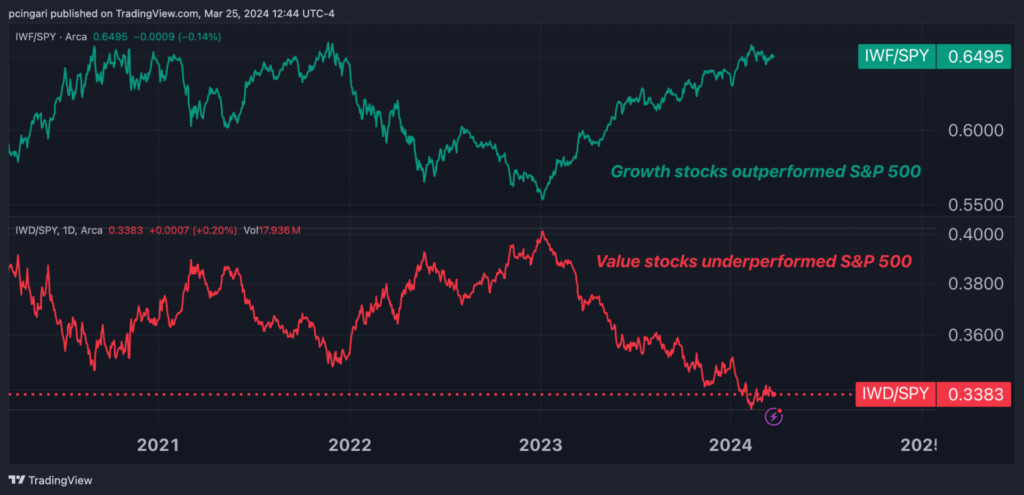Zinger Key Points
- Over the past year and especially over the last seven years, growth stocks have significantly outperformed value stocks,
- . From a technical standpoint, Bank of America's analysis suggests further upside potential for growth stocks.
- Join Chris Capre on Sunday at 1 PM ET to learn the short-term trading strategy built for chaotic, tariff-driven markets—and how to spot fast-moving setups in real time.
Bank of America’s technical analyst Stephen Suttmeier shed light on the diverging paths of value and growth stocks, underscored by the performance of the iShares Russell 1000 Growth ETF IWF and the iShares Russell 1000 Value ETF IWD.
Despite both reaching unprecedented heights, the future seems to favor one over the other, as Suttmeier highlighted in a note.
A Diverging Path: The Growth vs. Value Dichotomy
Over the past year, the gap between growth and value has widened, with growth outperforming value by 20 percentage points.
This divergence has become even more pronounced over the last seven years, reaching a staggering near 100 percentage point difference.
Chart: Growth Stocks Outperform Value, Doubling Relative Performance Over 7-Year Period

The underperformance of value stocks compared to growth is notably attributed to the absence of the so-called Magnificent 7 stocks in its portfolio. This includes tech giants and industry leaders absent from the IWD’s top holdings.
The iShares Russell 1000 Value ETF features Berkshire Hathaway Inc. BKR, JPMorgan Chase & Co. JPM, and ExxonMobil Corp. XOM as its top three holdings, with weights of 3.5%, 2.7%, and 2.1%, respectively.
Conversely, the iShares Russell 1000 Growth ETF boasts Microsoft Corp. MSFT, Apple Inc. AAPL, and Nvidia Corp. NVDA as its top three holdings, with weights of 12.1%, 9.5%, and 8.2%, respectively.
Notably, the growth ETF is heavily concentrated in three sectors — technology, consumer discretionary, and communication services. These sectors account for over 70% of the ETF’s composition, with the top 10 holdings comprising more than 50% of the portfolio.
Conversely, the value ETF demonstrates greater diversification across sectors and stocks, with financials, industrials, and healthcare collectively making up 50% of its portfolio. Moreover, the top 10 holdings represent only 17% of the value ETF’s portfolio.
Technical Analysis: Value vs. Growth
From a technical standpoint, Bank of America’s analysis indicates that IWF has breakout point supports near 312 and 287-285, with upward pattern counts from its 2022-2023 cup and handle pattern at 370 and 420. Following a bullish triangle completion in 2022-2023, IWF has surged to new all-time highs, suggesting further upside potential.

On the other hand, IWD shows breakout point supports at 171-169 and in the low 160s, with a bullish triangle target from 2022-2023 at 195 and an additional upside count at 208.
While both ETFs demonstrate potential for further gains, the analyst emphasizes that Growth has maintained its market leadership, whereas Value remains in a long-term lagging trend compared to the S&P 500 index.
Despite IWF’s relative strength stalling at its 2020 and 2021 highs versus the SPX, the leadership trend for Growth remains intact, particularly above its bullish and rising weekly relative Moving Averages (MAs).
Conversely, the lagging trend for IWD versus the SPX persists below the declining 13-, 26-, and 40-week MAs, along with chart resistance at the January 2024 lower high and the prior 2021-2020 lows relative to the SPX.

Now Read: Apple Analysts Unmoved By Antitrust Lawsuit: ‘Unmatched Brand Strength’
Image: Shutterstock
Edge Rankings
Price Trend
© 2025 Benzinga.com. Benzinga does not provide investment advice. All rights reserved.
date | ticker | name | Price Target | Upside/Downside | Recommendation | Firm |
|---|
Trade confidently with insights and alerts from analyst ratings, free reports and breaking news that affects the stocks you care about.